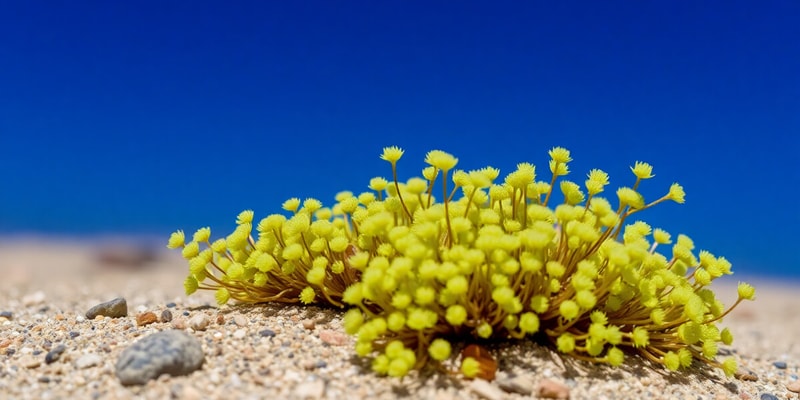Podcast Beta
Questions and Answers
What significant tolerance does Syntrichia caninervis exhibit?
Where is Syntrichia caninervis predominantly found?
What unique adaptation helps Syntrichia caninervis collect water?
What is the estimated half-lethal dose of gamma radiation for Syntrichia caninervis?
Signup and view all the answers
What is the recovery capability of Syntrichia caninervis after extreme water loss?
Signup and view all the answers
In which regions is Syntrichia caninervis NOT found?
Signup and view all the answers
Study Notes
Syntrichia caninervis Overview
- Identified as a species of desert moss significant for future space exploration and colonization.
- One of the most abundant desert mosses globally.
Environmental Tolerance
-
Demonstrates remarkable resilience to extreme environmental stress factors such as:
- Drought
- Cold temperatures
- Radiation exposure
-
Exhibits extreme desiccation tolerance, regaining function within seconds after losing over 98% of its water content.
-
Can survive ultra-low temperatures up to −196°C.
-
Highly resistant to gamma radiation, with a half-lethal dose estimated at 5,000 Gy.
Distribution
-
Widespread in dryland regions worldwide, particularly in:
- Gurbantunggut and Tengger Deserts (China)
- Mojave Desert (United States)
-
Found in mountainous areas, including:
- Pamir
- Tibet
- Middle East
- Antarctica
- Circumpolar regions
Unique Adaptations
- Features a tiny hair (awn) on each leaf’s end that aids in water collection, enhancing survival in arid conditions.
- Collects water in addition to that absorbed by the leaves, showcasing a specialized adaptation for harsh environments.
Studying That Suits You
Use AI to generate personalized quizzes and flashcards to suit your learning preferences.
Description
Explore the remarkable capabilities of 'Syntrichia caninervis', a species of desert moss that has potential implications for space exploration and colonization. This quiz delves into its unique tolerances to drought, cold, and extreme radiation, highlighting its significance for future environmental challenges in space. Test your knowledge about this extraordinary organism and its resilience in extreme conditions.
